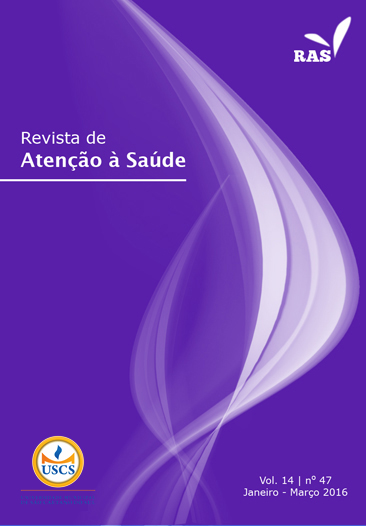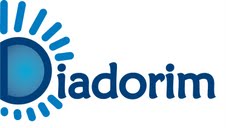Nutritional global subjective evaluation: instruments for screening for hospitalized children
DOI:
https://doi.org/10.13037/ras.vol14n47.3487Keywords:
Triage, nutritional status, malnutrition, hospitalization, childAbstract
Introduction: Over the past few years, several nutritional screening tools have been developed for application in hospitals. Those have, as main objective, the early identification of nutritional risk, which allow theevaluation and previous nutritional diagnosis enabling the professional to intervene before the worseningof malnutrition, preventing its consequences. The choice of a uniform and validated tool is an importantissue in the execution of nutritional screening. Objectives: To present four methods of nutritional screeningin pediatrics and discuss their advantages and disadvantages. Methodology: Survey of scientific articlespublished in databases like SciElo, LILACS, PubMed and MedLine from 1995 to 2015, in English,Portuguese and Spanish. The keywords used were: “nutritional screening”, “nutritional risk”, “nutritionalassessment” and “children”. Studies on nutritional screening tools developed for children and teenagerswere included and the studies concerning adults and elderly were excluded. Those which dealt with toolsdesigned for specific diseases were also excluded. Result: Of the four nutritional screening tools studied,the Screening Tool for Risk of Impaired Nutritional Status and Growth (STRONGkids) was presented asthe easiest and most practical tool to use compared to others, and may be applied by any health professionalin the moment of the patient’s admission. Conclusion: Based on the characteristics of each screeningmethod studied might not elect the most suitable because all of them have limitations in their application.Downloads
References
1. Raslan M., Gonzales MC, Dias MCG, Paes-Barbosa FC, Cecconello I, Waitzberg DL. Aplicabilidade dos métodos de triagem nutricional no paciente hospitalizado. Rev Nutr 2008; 21(5):553-61.
2. Liang X, Jiang ZM, Noalan MT, Wu X, Zhang H, Zheng Y et al. Nutritional risk, malnutrition (undernutrition), overweight, obesity and nutrition support among hospitalized patients in Beijing teaching hospitals. Asia Pac J Clin Nutr 2009; 18(1):54-62.
3. Giryes S, Leibovitz E, Matas Z, Fridman S, Gavish D, Shalev B et al. MEasuring NUtrition Risk in Hospitalized Patients: MENU, A. Hospital-Based Prevalence Survey. Isr Med Assoc J 2012; 14(7):405-9.
4. Karateke F, Ikiz GZ, Kuvvetli A, Menekse E, Das K, Ozyazici S et al. Evaluation of nutritional risk screening-2002 and subjective global assessment for general surgery patients: a prospective study. J Pak Med Assoc 2013; 63(11):1405-8.
5. Waitzberg DL, Caiaffa WT, Correia MI. Hospital malnutrition: The Brazilian national survey (IBRANUTRI): a study of 40000 patients. Nutrition 2001; 17 (7-8):573-80.
6. Brasil. Ministério da Saúde. Manual de atendimento da criança com desnutrição grave em nível hospitalar. Brasília: Ministério da Saúde; 2005.
7. Monte CMG, Sarni R. Tratamento hospitalar da criança gravemente desnutrida. Temas de Nutrição em Pediatria, [S.l.]. SBP 2002; 2(1):24-50.
8. Waitzberg DL, Correia MI. Nutritional assessment in the hospitalized patient. Am J Clin Nutr 2000; 6(5):531-8.
9. Correia MITD, Campos ACL. Prevalence of Hospital Malnutrition in Latin America: The Multicenter ELAN Study. Rev Nutr 2003; 19(1):823- 5.
10. Falbo AR, Bezerra AJG. Desnutrição grave: alguns aspectos clínicos e epidemiológicos de crianças hospitalizadas no Instituto materno infantil de Pernambuco (IMIP), Brasil. Cad Saúde Pública 2002; 18(1):1473-7.
11. Duchini L, Jordão AA, Brito TT, Diez-Garcia RW. Avaliação e monitoramento do estado nutricional de pacientes hospitalizados: uma proposta apoiada na opinião da comunidade científica. Rev Nutr 2010; 23(4):513-22.
12. Sorensen J, Kondrup J, Prokopowicz J, Schiesser M, Krãhenbuhl L, Meier R et al. EuroOOPS study group. EuroOOPS: An international, multicentre study to implement nutritional risk screening and evaluate clinical outcome. Clin Nutr 2008; 27(3):340-9.
13. Mello ED, Beghetto MG, Teixeira LB, Luft VC. A competência dos profissionais em identificar a desnutrição hospitalar. Rev Bras Nutr Clín 2003; 18(4):173-7.
14. Van Bokhorst de Van Der Schueren MA, Guaitoli PR, Jansma EP, VET HC. Nutrition screening tools: does one size fit all? A systematic review of screening tools for the hospital setting. Clin Nutri 2014; 33(1):39-58.
15. Ferreira HS, França AO. Evolução do estado nutricional de crianças submetidas à internação hospitalar. J Pediatr 2002; 1(78):491-6.
16. Monte CMG. Atendimento à criança desnutrida em ambulatório e comunidade. Temas de Nutrição em Pediatria, [S.l.]: Departamento Cientifico de Nutrição da Sociedade Brasileira de Pediatria 2002; 2:13-23.
17. Medeiros AQ, Pinto ICS, SILVA CR. Avaliação Nutricional. In: Vasconcelos MJOB, Barbosa JM, Pinto ICS, Lima TM, Araujo AFC. Nutrição Clínica: Obstetrícia e Pediatria. Rio de Janeiro: MedBook; 2011:211-38.
18. Araujo MAR, Lima LS, Ornelas GC, Logrado MHG. Análise comparativa de diferentes métodos de triagem nutricional do paciente internado. Com Ciências Saúde 2010; 21(4):331-42.
19. Barrocas A. Rastreamento nutricional. In: Waitzberg DL. Nutrição oral, enteral e parenteral na prática clínica. 4a ed. São Paulo: Atheneu; 2009:303-21.
20. Neelemaat F, Meijers J, Kruizenga H, Van Ballegooijen H, Schueren MB. Comparison of five malnutrition-screening tools in one hospital inpatient sample. J Clin Nurs 2011; 20(1):2144-52.
21. Brasil – Diário Oficial da República Federativa do Brasil. Portaria Secretaria de Atenção à saúde nº 131, de 8 de março de 2005. Organização e implantação de Serviços de Assistência e Centros de Referência de Alta complexidade [no âmbito do Sistema Único de saúde]. Available from: http://dtr2001.saude.gov.br/sas/PORTARIAS/Port2005/PT-131.htm.
22. Sermet-Gaudelus I, Poisson-Salomon S, Colomb V, Brusset MC, Mosser F, Berrier F et al. Simple pediatric nutritional risk score to identify children at risk of malnutrition. Am J Clin Nutr 2000; 72(1):64-70.
23. Secker DJ, Jeejeebhoy KN. Subjective Global Nutrition Assessment for children. Am J Clin Nutr 2007; 85(1):1083-9.
24. McCarthy H, Dixon M, Crabtree I, Eaton-Evanst MJ, McNulty H. The development and evaluation of the Screening Tool for the Assessment of Malnutrition in Pediatrics (STAMP©) for use by healthcare staff. J Hum Nutr Diet 2012; 25(4):311-8.
25. Hulst JM, Zwart H, Hop WC, Joosten KFM. Dutch national survey to test the STRONGkids nutritional risk screening tool in hospitalized children. Clin Nutr 2010; 29:106-11.
26. KONDRUP J, ALLISON SP, ELIA M, VELLAS B, PLAUTH M. ESPEN guidelines for nutrition screening 2002. Clin Nutr 2003; 22(4):415-21.
27. Moeeni V, Wakks T, Day AS. The STRONGkids nutritional risk screening tool can be used by pediatrics nurses to identify hospitalized children at risk. Acta Paediatr 2014; 103(12):528-31.
28. Ling RE, Hedges V, Sullivan PB. Nutritional risk in hospitalised children: anassessment of two instruments. e-SPEN, Eur e-Journal Clin Nutr Metab 2011; 6:153-7.
29. Moeeni V, Wakks T, Day AS. Assessment of nutritional status and nutritional riskin hospitalized Iranian children. Acta Paediatr 2012; 101(10):446-51.
30. More LRA, López MA, Álvarez HM, Chicano CS, Martínez GR, Ruzafa LE et al. Validation of a nutritional screening tool for hospitalized pediatric patients. Nutr Hosp 2012; 27(5):1429-36.
31. Wiskin AE, Owens DR, Cornelius VR, Wootton SA, Beattie RM. Paediatricnutrition risk scores in clinical practice: children with inflammatory boweldisease. J Hum Nutr Diet 2012; 25(4):319-22. 32. Mãrginean O, Pitea AM, Voidãzan S, Mãrginean C. Prevalence and Assessment of Malnutrition Risk among Hospitalized Children in Romania. J Health Popul Nutr 2014; 32(1):97-102.
33. Durakbasa ÇU, Fettahoglu S, Bayar A, Mutus M, Okur H. The prevalence of Malnutrition and Effectiveness of STRONGkids Tool in the Identification of Malnutrition Risks among Pediatric Surgical Patients. Balkan Med J 2014; 31(4):313-21.
34. Spagnuolo MI, Liguoro I, Chiatto F, Mambretti D, Guarino A. Application of a score system to evaluate the risk of malnutrition
in a multiple hospital setting. Riv Ital Ped 2013; 39:81-88.
35. Joosten KFM, Hulst JM. Nutritional screening tools for hospitalized children: Methodological considerations. Clin Nutr 2014; 33(1):1-5.
36. Monte CMG. Desnutrição: um desafio secular à nutrição infantil. J Ped 2000; 76(3):285-297.
37. World Health Organization. Physical status: the use and interpretation of anthropometry. Geneva; 1995. (Report of a WHO Expert Committee. Technical report series, 854).
Downloads
Published
Issue
Section
License
Copyright (c) 2016 Leorenia Alves Bousquet, Maria Luiza Ferreira Stringhini, Andrea Sugai Mortoza

This work is licensed under a Creative Commons Attribution-NonCommercial-NoDerivatives 4.0 International License.
Policy Proposal for Journals offering Free Delayed Access
Authors who publish in this magazine agree to the following terms:
- Authors maintain the copyright and grant the journal the right to the first publication, with the work simultaneously licensed under a Creative Commons Attribution License after publication, allowing the sharing of the work with recognition of the authorship of the work and initial publication in this journal.
- Authors are authorized to assume additional contracts separately, for non-exclusive distribution of the version of the work published in this magazine (eg, publishing in institutional repository or as a book chapter), with the acknowledgment of the authorship and initial publication in this journal.
- Authors are allowed and encouraged to publish and distribute their work online (eg in institutional repositories or on their personal page) at any point before or during the editorial process, as this can generate productive changes, as well as increase impact and citation of the published work (See The Effect of Open Access).









